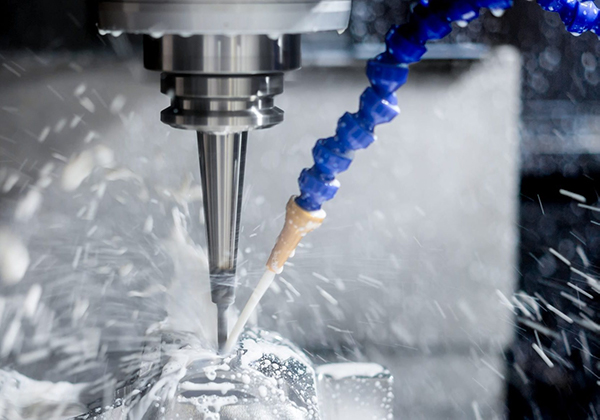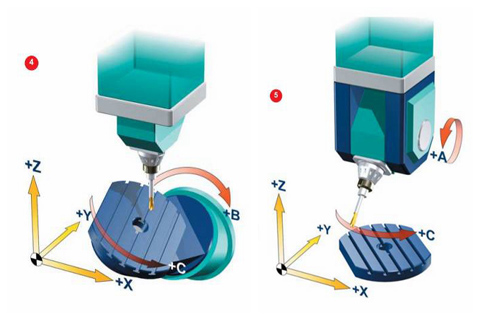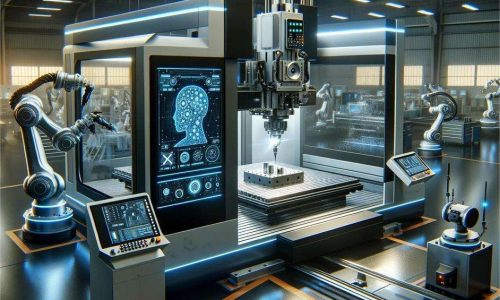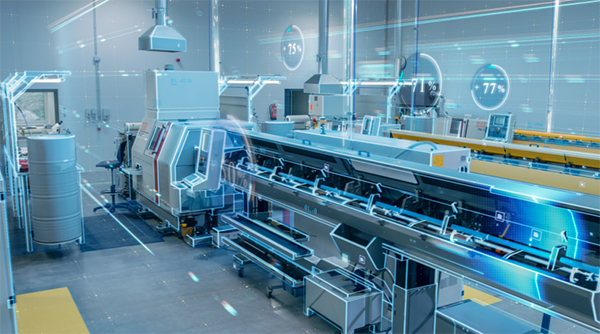The heart of every CNC machine is its axis system, which manages the motion and manipulation of both the workpiece and the cutting tool. With the advancement of technology, CNC axis systems have improved from 2-axis systems to multipurpose axis systems.
It is important to understand CNC axis systems in order to use modern CNC machines to their full potential. This article will explain different types of CNC axis, new control technologies, their applications in the industrial sector, and the future trends shaping this field.

Here are the types of CNC Axes:
The 2-axis CNC system is a basic configuration and is usually applied in very low-tech activities such as drilling or turning on the lathe. A 2-axis machine allows movement in X and Y coordinate planes only. These machines can cut or bore linearly; however, they are considered simple devices when it comes to complex geometries or multi-dimensional surfaces.
The 3-axis CNC system has vertical movement (Z-axis), which performs more complex machining. In this system, the tool can move in three axes (X, Y, and Z), thus enabling the manufacture of parts with more complex geometries. The 3-axis CNC systems are considered the norm in most industries and are sufficiently flexible for many processes such as milling, engraving, and so on.
The complexities of manufacturing requirements are increasing, and the availability of demand for 4 and 5 Axis CNC Systems is on the rise. A 4-axis CNC machine has an additional rotary axis, usually from the X-axis or Y-axis, which allows the tool to get to the workpiece at various angles without manual repositioning. This is a common scenario in industries like jewelry making or woodworking.

Moreover, a 5-axis CNC time system offers further assistance in adding a rotary axis, allowing free movement of the cutting tool in all planes. This kind of versatility and accuracy is unsurpassed, making 5-axis machines particularly suited for industries where precision is of the utmost importance, such as airplane and automobile manufacturing.
With time, 6-axis CNC machines are proving to be the new domain of machining, as more intricate parts can be manufactured with great accuracy. This is because the addition of the two additional rotational axes gives even more variety to the way in which a tool can reach a material, resulting in cuts that are less strenuous and more elaborate for sections.
Not only 5-axis supported machining being accepted in the market; 6-axis machines and even beyond are turning out to be the major enhancers in industries where the production of ultra-precision components is in high demand, such as orthopedic medical devices, complex shapes of aerospace parts, and intricate design samples.
CNC technology has become advanced in controlling axis movements. The following are critical breakthroughs in CNC axis control technologies.
The functioning of CNC cutting and milling machines largely depends on the rotary motors that provide axial movement in speed and precision. Improvements in the last generation of stepper and servo motors made it possible to increase both performance and speed dramatically. Closed loop motor control provided by servo motors is the most advanced. This means that this type of machine continuously monitors its position and adjusts in real-time.
Incorporating a digital twin is one of the most thrilling developments observed in regulating the CNC axis. A digital twin is a computerized representation of a machine or a process. This allows manufacturers to test the movements of the CNC axes before the actual production starts. This ability to carry out simulations helps find or reduce mistakes, improving the machining operations and even forecasting for maintenance. By digitally twinning a CNC machine, for example, manufacturers can play around with settings, tools, and materials without risking costly mistakes on the shop floor.
Smart sensors and Internet of Things (IoT) technologies embedded into CNC machines provide real-time control of the axes' movements. These sensors measure temperature, vibration, and position to ensure the machine does not operate outside a specified range. In case of any adverse effect on the machine's performance parameters, the system is designed to self-correct or warn the operators about the impending catastrophe.
The use of Artificial intelligence and machine learning in controlling CNC axes has become a big deal in recent years. This AI deep learning technology is capable of tracking the movements and performance of CNC machines over a long period and recognizing patterns that could not be identified by a human being. This allows the machine to optimize its own movements, adjusting speed and angles to improve efficiency and reduce tool wear.

CNC axis advancements have multiple applications across various industries. Let’s discuss them!
The automotive industry leverages CNC technology in developing precision components. From the engine block to the elements of the gears, a CNC machine—in particular, the 4-axis and 5-axis—allows companies to create complex structure components with accuracy. Machine parts with multiple angles in a single setup reduce production time and enhance consistency, which is essential for mass production in automotive manufacturing.
In the aviation industry, accuracy and safety cannot be compromised. CNC machines, especially 5- and 6-axis systems, are important for manufacturing aerospace parts like turbine blades, engine parts, and airframes. The ability to machine intricate geometries and maintain tight tolerances is critical for ensuring the safety and performance of aerospace products.
Medical device manufacturing has some of the most challenging machining processes when developing parts for products such as prosthetics, implants, and surgical tools. The use of 5-axis and 6-axis CNC machines is a normal practice when producing these devices, especially considering that they have to make complex geometries with the accurate precision required in the medical industry.
In advanced industries like custom jewelry manufacturing, sculpturing, and prototyping, advanced CNC axis systems create highly detailed and complicated designs. Such applications typically employ 4-axis and 5-axis CNC machines to carve intricate patterns, engravings, and forms that are impossible to achieve with traditional methods.
Multi-axis CNC equipment assists manufacturers in experimenting with complex geometries and materials without losing precision and quality. For instance, prototypes for automotive engine components or turbine blades can be prototyped accurately, thus making the functional test results meaningful. This feature shortens the time to market, which is one more reason why companies are willing to invest in advanced CNC axis technologies for prototyping.
Robust CNC axis systems have various benefits but come with challenges that must be addressed. Let’s discuss the challenges with solutions:
One of the most challenging aspects of CNC Machining is the need for precision and speed simultaneously. High-precision machining requires slower axis movements to maintain tight tolerances, especially when working with intricate parts or hard-to-machine materials. However, some industries, like automotive and electronics manufacturing, require high-speed machining to achieve set production goals.
Multi-axis CNC machines require sophisticated software to accurately manage tool paths, axis movements, and material engagement. However, integrating this software with machines from different manufacturers or legacy systems can be challenging.
Many CNC machine manufacturers leverage open-source platforms or proprietary software solutions that provide excellent compatibility across different machines.
The complexity of a CNC machine tends to rise with the number of available axes, which can lead to higher maintenance requirements. Multi-axis CNC machines have a more complex structure; more moving parts translate to more failure rates. If not properly managed, this enhances the risk of downtime and high maintenance.
A critical solution to this challenge is the utilization of predictive maintenance technologies. Sensors implanted in the CNC axis systems can register the machine's operational state in real time, identifying wear or mechanical stress even before it leads to a breakdown. This means that manufacturers can do maintenance work on schedule and avoid expensive delays caused by inefficiencies.
Several trends are shaping the future of CNC axis systems. These trends are expected to push the boundaries of what CNC machining can achieve, offering greater precision, flexibility, and integration with other manufacturing technologies.

One of the most thrilling developments within the field of CNC machining technology is the innovative manufacturing process known as hybrid manufacturing. This technology combines conventional CNC machining processes with additive manufacturing (3D printing) processes. Through the hybrid model, manufacturers can employ CNC axis systems to machine high-density parts while using additive processes to form features or create internal configurations that cannot be machined directly.
This hybrid model of a system utilizing CNC axes can be used not only for the convenient and fast removal of the material but also for redirecting the additive heads to operate continuously. This trend is exceptionally good for the manufacturers in the aerospace sector, where there is an excellent need for intricate, light structures.
The integration of CNC axis systems and robotics is yet another promising technology trend. In this configuration, CNC Machines and robotic arms are used simultaneously. The CNC axes are responsible for the machining process, while the robotic arms perform operations such as loading and unloading the workpiece, polishing, or assembly. This increases the employment of automation to a higher level of flexibility and productivity in the manufactured components.
Integration of robotics is often seen as an advantage, mainly in smart factories, where multiple machines and robotic systems work together seamlessly. Therein, a CNC Machine with a multi-axis can engage in intricate machinations while the robotic systems manage logistics—all ensuring high efficiency.
The future of CNC machining also heads toward self-learning systems, where artificial intelligence (AI) and machine learning (ML) are used to improve machine performance. AI algorithms analyze data from past machining operations to optimize tool paths, axis movements, and cutting speeds in these systems. This enables the machine to learn from previous jobs and improve efficiency over time.
For example, suppose a CNC machine identifies that a particular material type causes increased tool wear. In that case, the AI system can adjust the axis movements to minimize tool wear in future operations. Similarly, if the machine detects that specific machining parameters lead to better surface finishes, it can automatically apply those settings to similar jobs.
As industries strive to reduce their environmental impact, developing sustainable CNC machining practices is becoming a significant focus. CNC axis systems are designed to be more energy-efficient, reducing power consumption without sacrificing performance. This is particularly important in sectors like aerospace and automotive, where energy consumption during production processes can be substantial.
Moreover, sustainable CNC machining also involves reducing material waste. Multi-axis CNC systems have already contributed to this effort by allowing for more precise material removal and reducing excess material and scrap. Integrating recyclable materials and green manufacturing techniques, such as reusing chips and coolant, is becoming more common.
Modern CNC axis technologies are changing the manufacturing process in many industries by offering machinists the ability to work with high precision, versatility, and speed. The evolution of the CNC axis system enables manufacturers to respond to upward trends in manufacturing processes, from simple, operated 2-axis systems to 6-axis systems, and above all, they are capable of making detailed and complicated parts.
Innovations in control systems, such as incorporating digital twins, complex AI optimizations, and IoT integration, are further enhancing the capabilities of CNC machines that were previously impossible. As these technologies continue to develop, innovations in the trends above will increase the scope of CNC axis system operations in the near future with aerospace, automotive, and healthcare.
Trends such as hybrid manufacturing, robotics integration, self-learning machines, and sustainable methods will determine how CNC machining will shape the future. With the widespread adoption of those trends, CNC axis systems will have an important place in smart, automated, and sustainable factories, sustaining manufacturing innovations and efficiency levels for many years to come.